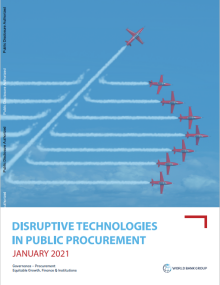Global Program on GovTech & Public Sector Innovation
Publications
-
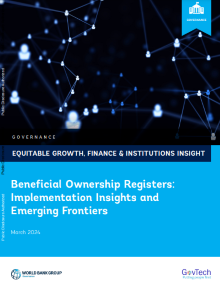 Beneficial Ownership Registers: Implementation Insights and Emerging Frontiers
Beneficial Ownership Registers: Implementation Insights and Emerging FrontiersThis EFI Insight distills critical insights from the implementation of Beneficial Ownership Registers (BORs) in Nigeria, North Macedonia, Kenya, and the United Kingdom. The experiences of these countries offer valuable lessons for similar reform efforts worldwide aimed at enhancing beneficial ownership transparency.
-
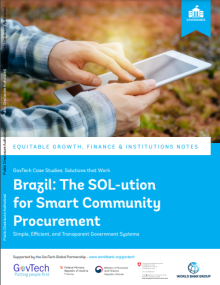 Brazil: The SOL-ution for Smart Community Procurement: Simple, Efficient, and Transparent Government Systems
Brazil: The SOL-ution for Smart Community Procurement: Simple, Efficient, and Transparent Government SystemsThis case study looks at Brazil's Online Bidding Solution (Solução Online de Licitação or SOL). SOL is a GovTech solution for community-level procurements carried out under community-driven development (CDD) projects, and it addresses the procurement challenges that the communities usually face. Piloting SOL in selected projects in Brazil showed the app’s potential to increase the efficiency, transparency, and governance of the procurement process. SOL is currently being upgraded with new features and translated into other languages to facilitate scale-up and use by other countries.
-
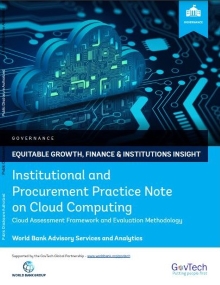 Data Classification Matrix and Cloud Assessment Framework
Data Classification Matrix and Cloud Assessment FrameworkThis data classification matrix and cloud assessment framework support the policy goals articulated in the World Bank’s Institutional and procurement practice note for cloud computing services in the public sector. The framework is intended to support World Bank client countries, practitioners, and multilateral and bilateral development partners to manage the risks of acquiring public cloud solutions. These suggestions are based on good practices identified in the practice note. The framework first offers a data classification scheme for government data and personally identifiable information (PII) of citizens that governments and their contractors handle based upon the confidentiality, integrity, and availability security objectives.
-
 Institutional and Procurement Practice Note on Cloud Computing
Institutional and Procurement Practice Note on Cloud ComputingDespite widespread awareness of the benefits of cloud computing, authorities in most of the World Bank's client countries have not explored the opportunity of adopting cloud computing solutions. Adopting a hybrid cloud model, which leverages the cloud services from the private sector to work in conjunction with the G-Cloud, can offer immense opportunities to save costs, improve security, enhance performance, and strengthen resilience in a post-COVID-19 world. However, client governments need guidance to change their policy response on cloud computing - from risk avoidance to risk management.
-
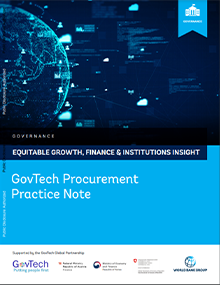 GovTech Procurement Practice Note
GovTech Procurement Practice NoteThe objective of the GovTech Procurement Practice Note is to explore how to better procure GovTech solutions. The note provides recommendations to World Bank teams and client countries on how to assess and prepare for the application of GovTech systems. GovTech is defined as the use of technology to support government operations, service delivery and transparency. It is a mechanism for whole of government public sector modernization that places the citizen at the center of the reform (World Bank 2020). As an example, e-Government Procurement (eGP), which is discussed in detail in this paper is a specific technology sub-category of GovTech that is applied to manage and automate public procurement processes.
-
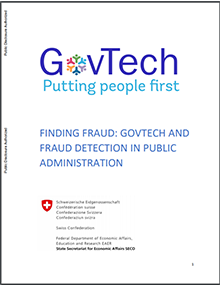 Finding Fraud: GovTech and Fraud Detection in Public Administration
Finding Fraud: GovTech and Fraud Detection in Public AdministrationThis paper examines the most promising current and new technologies that can be applied to detect and prevent fraud and corruption in public administration, with a focus on procurement, integrated financial management information systems (IFMIS) and human resource (HR) systems. The paper is intended to be a practical guide for practitioners, policy makers and government officials. The paper also addresses the important related analog (non-technical) legal, policy and political requirements for the success of digital anti-fraud measures.
-
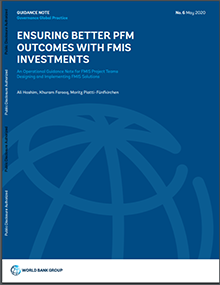 Ensuring Better PFM Outcomes with FMIS Investments
Ensuring Better PFM Outcomes with FMIS InvestmentsThis Guidance Note draws on the accumulated literature, case studies, studies from the World Banks’s Independent Evaluation Group, Implementation Completion and Results Reports, the World Bank’s experience, and emerging trends in technology to provide operational guidance to teams who are engaged in implementing, enhancing, or maintaining FMIS. A peer reviewer panel of leading experts from the World Bank, International Monetary Fund, and the private sector — representing both Big Tech and startups — also provided critical reviews and insights that enormously enriched this work.
-
Disruptive Technologies in Public Procurement
This study presents the conclusions drawn from research on a selection of technologies identified as “disruptive” that could potentially be useful to public procurement. The report includes several case studies of experience gained from the deployment of these technologies around the world, complemented by desk research, allowing for an assessment of the technologies’ maturity level and their capacity to create value in the public procurement process.
-
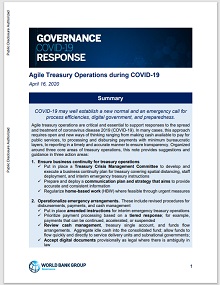 Agile Treasury Operations during COVID-19
Agile Treasury Operations during COVID-19This note provides suggestions and guidance in three action areas: ensuring business continuity for treasury operations, operational emergency arrangements, and management of the post-pandemic environment through recovery, reconstruction, and resilience. The paper reviews agile treasury operations and how critical and essential this is in the support of responses to the spread and treatment of COVID-19.
-
 Treasury Single Account Rapid Assessment Toolkit
Treasury Single Account Rapid Assessment ToolkitThis rapid assessment toolkit is designed to assist the government officials in clarifying the current status of TSA operations, and identifying possible improvements in practices/processes, regulations, information security, and payment systems. The key purpose of this exercise is to ensure that Public Financial Management (PFM) reforms supported by ongoing FMIS activities are sufficiently focused on the design of basic TSA processes that improve cash management.
-
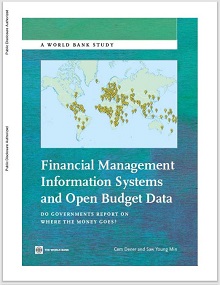 Financial Management Information Systems
Financial Management Information SystemsThis study presents the World Bank’s experience with financial management information systems which include substantial ICT components, in order to share the achievements and challenges observed, and provide guidance for improving the performance of future projects. A second publication examines whether or not government's report on where the money goes: Financial Management Information Systems and Open Budget.
